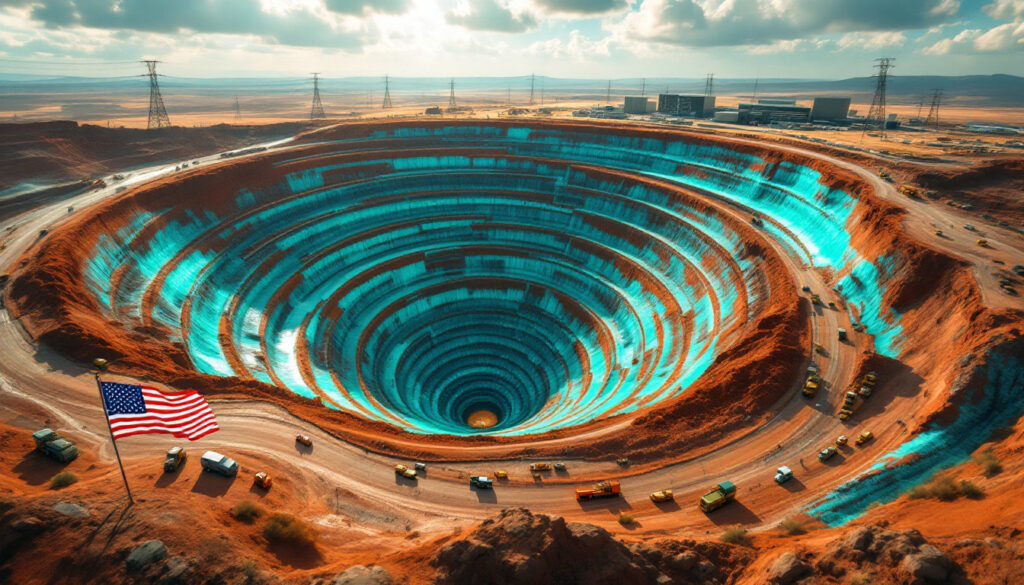Why Is the US Facing a Critical Copper Supply Gap?
The United States stands at a critical juncture in its resource security, facing an unprecedented copper supply challenge that threatens both economic growth and national security. As electrification accelerates across transportation, energy, and digital infrastructure, electrifying copper demand is surging to historic levels while domestic production remains constrained by regulatory and development hurdles.
According to BHP Americas president Brandon Craig, speaking at the Energy Future Forum in 2025, this dynamic is creating a widening gap between supply and demand that has profound implications for America's industrial future and energy transition goals.
The Widening Domestic Copper Deficit
The numbers paint a stark picture of America's copper vulnerability. US copper demand is projected to reach approximately 3.5 million tonnes by 2025, while domestic production remains limited to just 1 million tonnes annually. This creates a substantial 2.5 million tonne supply gap that must be addressed through either rapid development of new mining projects or increased dependence on foreign imports.
"The scale of this challenge cannot be overstated," noted Brandon Craig at the Energy Future Forum. "We're looking at a copper deficit that threatens to undermine industrial sovereignty and energy transition goals unless addressed with urgency."
This supply-demand imbalance isn't merely a theoretical concern for future decades—it's already beginning to manifest in tightening markets and strategic vulnerabilities that impact everything from grid resilience to manufacturing capabilities.
The Permitting and Development Timeline Challenge
Perhaps the most significant barrier to increasing domestic copper production is the extraordinarily lengthy mining permitting process for new mining projects. The Resolution copper project in Arizona—a joint venture between mining giants BHP and Rio Tinto—provides a sobering case study of these challenges:
- Permit application submitted in 2012
- As of 2025, still navigating complex legal processes
- An estimated 5 additional years needed for construction after permitting
- Total timeline exceeding 20 years from initial application to production
"You'll need five Resolution-sized mines developed by 2035 to be self-sufficient in copper in the US," Craig explained. "And that mine has been in progress for over 20 years. So that gives you a sense of the scale of the challenge."
This extended timeline makes it virtually impossible for the United States to achieve copper self-sufficiency through domestic production alone within the timeframe required by energy transition goals and technology deployment schedules.
How Is Global Copper Demand Transforming?
The global copper landscape is undergoing a profound transformation driven by concurrent revolutions in energy, transportation, and digital infrastructure. Traditional demand forecasts have failed to capture the convergence of these trends, leading to significant underestimation of future copper requirements.
The Unexpected AI and Data Center Impact
Perhaps the most significant blind spot in copper demand forecasting has been the explosive growth of artificial intelligence and data center infrastructure. According to Marty Durbin of the US Chamber of Commerce, global electricity demand growth in 2024 was 60% higher than historical averages, largely due to the power requirements of new data centers and AI computing clusters.
"The International Energy Agency's 2023 World Energy Outlook completely missed the impact of AI and data centers," Durbin noted at the Energy Future Forum. "It was a critical oversight that led to significant underestimation of both energy and materials demand."
The scale of this oversight is substantial:
- Data center energy consumption is projected to triple over the next decade
- Each hyperscale facility requires extensive copper for power distribution systems
- Cooling infrastructure incorporates significant copper components
- Power delivery for AI systems demands high-conductivity materials
This unexpected surge has prompted S&P Global to revise its comprehensive "Future of Copper" study to incorporate AI-driven demand, as confirmed by Daniel Yergin, vice chairman of S&P Global.
The "More" Economy Driving Resource Demand
The current economic landscape can be summarized by a single word: "more." According to energy experts at the US Chamber of Commerce, we are experiencing unprecedented resource demands across multiple sectors simultaneously:
- More electrons (electricity)
- More transmission lines
- More critical minerals
- More factories
- More infrastructure
"This isn't simply about transitioning from one energy source to another," Durbin explained. "It's about a fundamental expansion of global resource requirements to support electrification, digitalization, and economic growth simultaneously."
This "more economy" creates a challenging dynamic where copper supply chains must expand dramatically just to maintain current capabilities, let alone support growth in renewable energy, electric vehicles, and digital infrastructure.
What Factors Are Constraining Copper Supply?
While demand accelerates, copper supply faces multiple constraints that limit the ability to rapidly increase production. These challenges span geological, financial, regulatory, and geopolitical dimensions.
The Project Development Reality
According to BHP's internal analysis shared at the Energy Future Forum, there simply aren't enough copper projects currently under development to satisfy the projected global copper supply forecast of approximately 50 million tonnes by 2050. Several factors contribute to this project deficit:
- Increasing cost and complexity of building new copper projects
- Extended permitting timelines (5-10 years in developed nations)
- Technical challenges of developing lower-grade deposits
- Financial hurdles for capital-intensive projects with long payback periods
"There are not enough projects in the pipeline to meet projected demand," Craig emphasized. "The scarcity of high-quality resources and persistent delays in project development compound the challenge."
The typical timeline for new copper projects now spans 10-20 years from discovery to production, making it impossible to respond quickly to sudden demand increases or supply disruptions.
The Geographic Concentration of Quality Resources
Complicating the supply challenge is the geographic reality of copper resources—high-quality deposits are concentrated in specific regions with the right geological conditions:
| Region | Characteristics | Strategic Significance |
|---|---|---|
| Chile | High-grade porphyry deposits | World's largest producer with mature mining sector |
| Argentina | Emerging copper belt | Significant untapped potential but political challenges |
| DRC | High-grade Central African deposits | Complex operating environment with geopolitical risks |
| Zambia | Part of the Central African copper belt | Improving investment climate with historical mining legacy |
These regions possess the quality, grade, and scale necessary to support global copper demand, making them strategically important regardless of domestic production goals. As Brandon Craig noted, "These countries have the geological endowment that simply doesn't exist elsewhere at the same scale."
This geographic reality means that even countries with significant domestic mining capacity will need to engage with these regions to secure adequate copper supplies.
What Would US Copper Self-Sufficiency Require?
The question of whether the United States can achieve copper self-sufficiency is central to discussions about resource security and industrial policy. The mathematics of supply and demand provide a sobering perspective on this challenge.
The Resolution Project Perspective
The Resolution copper project in Arizona offers a useful reference point for understanding the scale of development needed:
- Potential production of approximately 500,000 tonnes of copper annually
- Would satisfy roughly 20% of the projected US copper deficit
- Five similar-sized projects would be needed to achieve self-sufficiency
- Development timeline makes this impossible before 2035
"Even if we expedited every aspect of the permitting process starting today," Craig explained, "the construction and development timelines would still push production well beyond the timeframe needed to support near-term energy transition goals."
This reality check highlights the need for a more nuanced approach to copper security that balances domestic production ambitions with pragmatic supply chain strategies.
The Global Context of Copper Security
As Brandon Craig emphasized at the Energy Future Forum, "Copper shortages are a global problem, not a local problem." This global perspective suggests that resource security requires a multifaceted approach:
- Strategic partnerships with copper-producing nations
- Investment in overseas mining projects
- Trade agreements that prioritize critical mineral access
- Diversification of supply sources to reduce vulnerability
"The notion that any country can be entirely self-sufficient in all critical minerals is unrealistic," Craig noted. "The more pragmatic approach is to ensure secure supply chains with reliable partners."
This perspective aligns with broader trends in critical mineral strategies, where security of supply rather than complete self-sufficiency has become the primary objective.
How Is the Global Copper Landscape Changing?
The struggle for copper resources is reshaping international relations and industrial strategies as countries position themselves for the electrified future.
The Shifting Balance of Power
The global copper landscape is undergoing a significant power shift with profound geopolitical implications:
- China currently controls 55% of refined copper supply
- Chinese corporations are aggressively investing in global copper resources
- Competition for copper assets is intensifying among major economies
- Resource nationalism is rising in copper-producing nations
This concentration of control creates strategic vulnerabilities for countries dependent on copper for energy transition and industrial development. The competition for resources is increasingly influencing diplomatic relationships and trade policies.
The Turning Point in Global Economic Systems
Daniel Yergin, vice chairman of S&P Global, offered a broader perspective on these changes: "We're at the turning point of how the global economic system works. Supply and demand dynamics are reshaping international relationships."
This transformation includes:
- Deglobalization of supply chains
- Increased focus on resource security
- Competition rather than cooperation in resource development
- New alliances forming around critical mineral access
"The copper challenge is part of a larger reconfiguration of global resource politics," Yergin explained. "We're moving from an era of relative resource abundance to one of strategic competition and constraint."
This shift requires new approaches to industrial policy, trade relationships, and strategic planning to ensure access to the materials necessary for economic security and energy transition.
How Will Copper Shortages Impact Key Industries?
The implications of copper constraints extend across multiple sectors, potentially affecting everything from renewable energy deployment to transportation electrification and digital infrastructure.
The Renewable Energy Transition
The renewable energy transition relies heavily on copper resources:
- Wind turbines require 2-6 tonnes of copper per megawatt
- Solar installations use approximately 5 tonnes of copper per megawatt
- Grid infrastructure upgrades demand significant copper resources
- Energy storage systems incorporate substantial copper components
Copper shortages could significantly impact renewable deployment targets by increasing costs, extending project timelines, or forcing design compromises that affect efficiency or reliability.
Electric Vehicle Manufacturing
Electric vehicles represent another copper-intensive sector facing potential constraints:
- Average EV contains 80-85 kg of copper (vs. 20-25 kg in conventional vehicles)
- Charging infrastructure requires additional copper resources
- Battery production incorporates copper components
- Manufacturing facilities depend on copper-intensive electrical systems
Limited copper supply may constrain EV production targets, increase vehicle costs, or delay charging infrastructure deployment, potentially slowing the transportation electrification timeline.
Data Centers and Digital Infrastructure
The fastest-growing source of copper demand comes from digital infrastructure:
- Hyperscale data centers require extensive copper wiring
- AI systems need robust power delivery systems
- Cooling infrastructure incorporates copper components
- Transmission infrastructure to support data centers demands significant copper resources
"The convergence of AI development and energy transition creates unprecedented materials demand," noted Marty Durbin. "We're building two resource-intensive systems simultaneously, both requiring significant copper inputs."
What Solutions Could Address the Copper Supply Challenge?
Addressing the copper supply gap will require a multifaceted approach combining policy reform, technological innovation, and strategic international engagement.
Domestic Policy Approaches
Several policy changes could help accelerate domestic copper production:
- Streamlining the permitting process for critical mineral projects
- Establishing clear timelines for permit decisions
- Balancing environmental protection with resource security needs
- Creating expedited pathways for projects deemed critical to national security
However, even with these reforms, the geological reality and development timelines mean domestic production alone cannot fully address the supply gap in the near term.
International Supply Chain Strategies
Given the geographic reality of copper resources, securing reliable international supply chains will be essential:
- Developing strategic partnerships with copper-producing nations
- Diversifying supply sources to reduce vulnerability to disruptions
- Securing long-term offtake agreements with reliable producers
- Investing in overseas mining projects to ensure supply access
"We need to think about copper security rather than copper self-sufficiency," Craig suggested. "That means developing relationships with reliable suppliers and investing in projects internationally."
What Does the Future of Copper Supply Look Like?
While the copper challenge is significant, several emerging trends offer potential pathways to address supply constraints over the longer term.
Innovation in Recycling and Substitution
While primary production remains essential, other approaches may help address shortages:
- Advanced copper recycling technologies improving recovery rates
- Material substitution where technically feasible (aluminum for some applications)
- Efficiency improvements reducing copper intensity in certain products
- Urban mining of electronic waste providing secondary supply sources
However, as Brandon Craig cautioned, "Even with 100% recycling of available copper scrap, significant new primary production would still be needed to meet anticipated demand growth."
New Exploration Frontiers
The search for copper is expanding to previously overlooked regions:
- Deep-sea mining potential (though with environmental concerns)
- Advanced exploration for copper in mature mining districts using new technologies
- Reprocessing of historical mine waste with improved recovery methods
- Lower-grade deposits becoming economically viable at higher copper price prediction
These frontiers may expand the resource base over time, but development timelines mean they represent medium to long-term solutions rather than immediate answers to supply constraints.
FAQ: Understanding the US Copper Security Challenge
Why is copper considered the metal of electrification?
Copper's unique properties make it essential for electrification, renewable energy, and modern technology:
- Highest electrical conductivity of any non-precious metal
- Excellent thermal conductivity for heat management
- Corrosion resistance ensuring long-term reliability
- Malleability and ductility for versatile applications
- Antimicrobial properties providing additional benefits in certain uses
These characteristics make copper difficult to replace in many critical applications, especially those involving electrical conductivity or heat transfer.
Can recycling solve the copper shortage?
While recycling is important, it cannot fully address projected demand growth:
- Even with 100% recycling of available copper scrap, significant new primary production would still be needed
- The long lifespan of copper in many applications (20+ years in buildings) limits immediate recycling potential
- Growing demand means the total stock of copper in use continues to expand
- Technical challenges in separating copper from complex products
Recycling will play an increasingly important role in copper supply but must be complemented by responsible primary production.
What timeline should we expect for new copper projects?
The development timeline for new copper projects is extensive:
- 10-20 years from discovery to production under current conditions
- Permitting processes typically requiring 5-10 years in developed nations
- Construction and commissioning adding 3-5 years
- Financing challenges extending timelines further
This extended timeline means that projects starting development today would likely not contribute significant production until the 2030s, highlighting the urgency of beginning development now for future needs.
How might copper shortages affect consumers?
Consumers may experience several impacts from copper constraints:
- Higher prices for electronics, vehicles, and renewable energy systems
- Product availability constraints as manufacturers prioritize allocation
- Potential design changes to reduce copper content in certain products
- Delayed rollout of infrastructure like EV charging stations
Industry Perspective: The copper challenge represents a critical constraint on our electrified future. Addressing it requires collaborative approaches spanning policy reform, technology innovation, and international cooperation. As Daniel Yergin noted, "We're at an inflection point where resource constraints meet accelerating demand—how we navigate this challenge will shape industrial development for decades to come."
Want to Stay Ahead of Critical Mineral Discoveries?
Discovery Alert's proprietary Discovery IQ model provides instant notifications on significant ASX mineral discoveries like copper, transforming complex data into actionable investment insights before the broader market catches on. Explore historical discovery returns and position yourself for future opportunities at Discovery Alert's discoveries page.




